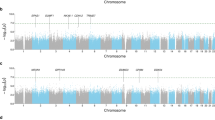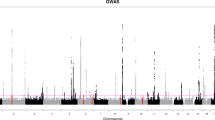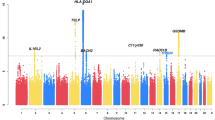Abstract
Asthma is a chronic lung disease that has a high prevalence. The therapeutic intervention of this disease can be made more effective if genetic variability in patients’ response to medications is implemented. However, a clear picture of the genetic architecture of asthma intervention response remains elusive. We conducted a genome-wide association study (GWAS) to identify drug response-associated genes for asthma, in which 909 622 SNPs were genotyped for 120 randomized participants who inhaled multiple doses of glucocorticoids. By integrating pharmacodynamic properties of drug reactions, we implemented a mechanistic model to analyze the GWAS data, enhancing the scope of inference about the genetic architecture of asthma intervention. Our pharmacodynamic model observed associations of genome-wide significance between dose-dependent response to inhaled glucocorticoids (measured as %FEV1) and five loci (P=5.315 × 10−7 to 3.924 × 10−9), many of which map to metabolic genes related to lung function and asthma risk. All significant SNPs detected indicate a recessive effect, at which the homozygotes for the mutant alleles drive variability in %FEV1. Significant associations were well replicated in three additional independent GWAS studies. Pooled together over these three trials, two SNPs, chr6 rs6924808 and chr11 rs1353649, display an increased significance level (P=6.661 × 10−16 and 5.670 × 10−11). Our study reveals a general picture of pharmacogenomic control for asthma intervention. The results obtained help to tailor an optimal dose for individual patients to treat asthma based on their genetic makeup.
This is a preview of subscription content, access via your institution
Access options
Subscribe to this journal
Receive 6 print issues and online access
$259.00 per year
only $43.17 per issue
Buy this article
- Purchase on Springer Link
- Instant access to full article PDF
Prices may be subject to local taxes which are calculated during checkout




Similar content being viewed by others
References
Fanta CH . Asthma. N Engl J Med 2009; 360: 1002–1014.
Szefler SJ . Advancing asthma care: the glass is only half full!. J Allergy Immunol 2011; 128: 485–494.
Apter AJ . Advances in adult asthma diagnosis and treatment and HEDQ in 2010. J Allergy Clin Immunol 2011; 127: 116–122.
National Institutes of Health, National Heart, Lung, and Blood Institute, National Asthma Education and Prevention Program. Expert panel report 3: guidelines for the diagnosis and management of asthma. NIH Publication no. 07-4051. Available at: http://www.nhlbi.nih.gov/guidelines/asthma/index.htm. Accessed July 16, 2011.
Yoshihara S . Early intervention for infantile and childhood asthma. Expert Rev Clin Immunol 2010; 6: 247–255.
Bouzigon E, Corda E, Aschard H, Dizier MH, Boland A, Bousquet J et al. Effect of 17q21 variants and smoking exposure in early-onset asthma. N Engl J Med 2008; 359: 1985–1994.
Moffatt MF, Kabesch M, Liang L, Dixon AL, Strachan D, Heath S et al. Genetic variants regulating ORMDL3 expression contribute to the risk of childhood asthma. Nature 2007; 448: 470–473.
Moffatt MF, Gut IG, Demenais F, Strachan DP, Bouzigon E, Heath S et al. A large-scale, consortium-based genomewide association study of asthma. N Engl J Med 2010; 363: 1211–1221.
Repapi E, Sayers I, Wain LV, Burton PR, Johnson T, Obeidat M et al. Genome-wide association study identifies five loci associated with lung function. Nat Genet 2010; 42: 36–44.
Hancock DB, Eijgelsheim M, Wilk JB, Gharib SA, Loehr LR, Marciante KD et al. Meta-analyses of genome-wide association studies identify multiple loci associated with pulmonary function. Nat Genet 2010; 42: 45–52.
Manolio TA . Genomewide association studies and assessment of the risk of disease. N Engl J Med 2010; 363: 166–176.
Daly AK . Genome-wide association studies in pharmacogenomics. Nat Rev Genet 2010; 11: 241–246.
Klein TE, Altman RB, Eriksson N, Gage BF, Kimmel SE, Lee MT et al. Estimation of the warfarin dose with clinical and pharmacogenetic data. N Engl J Med 2009; 360: 753–764.
Daly AK . Pharmacogenomics of anticoagulants: steps toward personal dosage. Genome Med 2009; 1: 10.
Tse SM, Tantisira K, Weiss ST . The pharmacogenetics and pharmacogenomics of asthma therapy. Pharmacogenomics J 2011; 11: 383–392.
Ge D, Fellay J, Thompson AJ, Simon JS, Shianna KV, Urban TJ et al. Genetic variation in IL28B predicts hepatitis C treatment-induced viral clearance. Nature 2009; 461: 399–401.
Suppiah V, Moldovan M, Ahlenstiel G, Berg T, Weltman M, Abate ML et al. IL28B is associated with response to chronic hepatitis C interferon-α and ribavirin therapy. Nat Genet 2009; 41: 1100–1104.
Tanaka Y, Nishida N, Sugiyama M, Kurosaki M, Matsuura K, Sakamoto N et al. Genome-wide association of IL28B with response to pegylated interferon-α and ribavirin therapy for chronic hepatitis C. Nat Genet 2009; 41: 1105–1109.
Shuldiner AR, O'Connell JR, Bliden KP, Gandhi A, Ryan K, Horenstein RB et al. Association of cytochrome P450 2C19 genotype with the antiplatelet effect and clinical efficacy of clopidogrel therapy. JAMA 2009; 302: 849–857.
Cooper GM, Johnson JA, Langaee TY, Feng H, Stanaway IB, Schwarz UI et al. A genome-wide scan for common genetic variants with a large influence on warfarin maintenance dose. Blood 2008; 112: 1022–1027.
Teichert M, Eijgelsheim M, Rivadeneira F, Uitterlinden AG, van Schaik RH, Hofman A et al. A genome-wide association study of acenocoumarol maintenance dosage. Hum Mol Genet 2009; 18: 3758–3768.
Takeuchi F, McGinnis R, Bourgeois S, Barnes C, Eriksson N, Soranzo N et al. A genome-wide association stud confirms VKORC1, CYP2C9, and CYP4F2 as principal genetic determinants of warfarin dose. PLoS Genet 2009; 5: e1000433.
SEARCH Collaborative Group, Link E, Parish S, Armitage J, Bowman L, Heath S, Matsuda F et al. SLCO1B1 variants and statin-induced myopathy – a genomewide study. N Engl J Med 2008; 359: 789–799.
Daly AK, Donaldson PT, Bhatnagar P, Shen Y, Pe'er I, Floratos A et al. HLA.B*5701 genotype is a major determinant of drug-induced liver injury due to flucloxacillin. Nat Genet 2009; 41: 816–819.
Van Steen K, McQueen MB, Herbert A, Raby B, Lyon H, Demeo DL et al. Genomic screening and replication using the same data set in family based association testing. Nat Genet 2005; 37: 683–691.
Herbert A, Gerry NP, McQueen MB, Heid IM, Pfeufer A, Illig T et al. A common genetic variant is associated with adult and childhood obesity. Science 2006; 312: 279–283.
Lasky-Su J, Lyon HN, Emilsson V, Heid IM, Molony C, Raby BA et al. On the replication of genetic associations: timing can be everything!. Am J Hum Genet 2008; 82: 849–858.
Bertram L, Lange C, Mullin K, Parkinson M, Hsiao M, Hogan MF et al. Genome-wide association analysis reveals putative Alzheimer’s disease susceptibility loci in addition to APOE. Am J Hum Genet 2008; 83: 623–632.
Tantisira KG, Lasky-Su J, Harada M, Murphy A, Litonjua AA, Himes BE et al. Genomewide association between GLCCI1 and response to glucocorticoid therapy in asthma. N Engl J of Med 2011; 365: 1173–1183.
Wu RL, Tong CF, Mauger D, Mauger D, Tantisira K, Szefler SJ et al. A conceptual framework for pharmacodynamic genome-wide association studies in pharmacogenomics. Drug Discov Today 2011; 16: 804–890.
Gong Y, Wang Z, Liu T, Zhao W, Zhu Y, Johnson JA et al. A statistical model for functional mapping of quantitative trait loci regulating drug response. Pharmacogenomics J 2004; 4: 315–321.
Lin M, Aqvilonte C, Johnson JA, Wu R . Sequencing drug response with HapMap. Pharmacogenomics J 2005; 5: 149–156.
Lin M, Hou W, Li HY, Johnson JA, Wu R . Modeling sequence-sequence interactions for drug response. Bioinformatics 2007; 23: 1251–1257.
Wu RL, Lin M . Statistical and Computational Pharmacogenomics. Chapman & Hall/CRC: London, 2008.
Martin RJ, Szefler SJ, Chinchilli VM, Kraft M, Dolovich M, Boushey HA et al. Systemic effect comparisons of six inhaled corticosteroid preparations. Am J Resp Crit Care Med 2002; 165: 1377–1383.
Boushey HA, Sorkness CA, King TS, Sullivan SD, Fahy JV, Lazarus SC et al. Regular vs. intermittent controller therapy for mild persistent asthma. N Engl J Med 2005; 352: 1519–1528.
Lazarus SC, Boushey HA, Fahy JV, Chinchilli VM, Lemanske RF Jr, Sorkness CA et al. Long-acting beta2-agonist monotherapy vs continued therapy with inhaled corticosteroids in patients with persistent asthma: a randomized controlled trial. JAMA 2001; 285: 2583–2593.
Giraldo J . Empirical models and Hill coefficients. Trend Pharmacolog Sci 2003; 24: 63–65.
Diggle PJ, Heagerty P, Liang KY et al Analysis of Longitudinal Data. Oxford University Press: Oxford, UK, 2002.
Zimmerman DL, Nunez-Anton V . Parametric modeling of growth curve data: an overview (with discussion). Test 2001; 10: 1–73.
Zhao W, Hou W, Littell RC, Wu R . Structured antedependence models for functional mapping of multivariate longitudinal quantitative traits. Stat Appl Mol Genet Biol 2005; 4: Article 33.
Yap JS, Li Y, Das K, Li J, Wu R . Functional mapping of reaction norms to multiple environmental signals through nonparametric covariance estimation. BMC Plant Biol 2011; 11: 23.
Devlin B, Roeder K . Genomic control for association studies. Biometrics 1999; 55: 997–1004.
Mustavich LF, Miller P, Kidd KK, Zhao H . Using a pharmacokinetic model to relate an individual's susceptibility to alcohol dependence to genotypes. Hum Hered 2010; 70: 177–193.
Ahn K, Luo JT, Berg A, Keefe D, Wu R . Functional mapping of drug response with pharmacodynamic-pharmcokinetic principles. Trend Pharmacol Sci 2010; 31: 306–311.
Yeh TY, Sbodio JI, Nguyen MT, Meyer TN, Lee RM, Chi NW . Tankyrase-1 overexpression reduces genotoxin-induced cell death by inhibiting PARP1. Mol Cell Biochem 2005; 276: 183–192.
Kuschel L, Hansel A, Schonherr R, Weissbach H, Brot N, Hoshi T et al. Molecular cloning and functional expression of a human peptide methionine sulfoxide reductase (hMsrA). FEBS Lett 1999; 456: 17–21.
Lanuza GM, Gosgnach S, Pierani A, Jessell TM, Goulding M . Genetic identification of spinal interneurons that coordinate left-right locomotor activity necessary for walking movements. Neuron 2004; 42: 375–386.
Maes T, Barcelo A, Buesa C . Neuron navigator: a human gene family with homology to unc-53, a cell guidance gene from Caenorhabditis elegans. Genomics 2002; 80: 21–30.
Persson B, Kallberg Y, Bray JE, Bruford E, Dellaporta SL, Favia AD et al. The SDR (short-chain dehydrogenase/reductase and related enzymes) nomenclature initiative. Chem Biol Interact 2009; 178: 94–98.
Tang J, Gary JD, Clarke S, Herschman HR . PRMT 3, a type I protein arginine N-methyltransferase that differs from PRMT1 in its oligomerization, subcellular localization, substrate specificity, and regulation. J Biol Chem 1998; 273: 16935–16945.
Hasson T, Skowron JF, Gilbert DJ, Avraham KB, Perry WL, Bement WM et al. Mapping of unconventional myosins in mouse and human. Genomics 1997; 36: 431–439.
Rastogi D, Suzuki M, Greally JM . Differential epigenome-wide DNA methylation patterns in childhood obesity-associated asthma. Sci Rep 2013; 3: 2164.
Acknowledgements
We thank Kwangmi Ahn for her assistance in data management. This research was funded by grants NIH/NHLBI-1U10HL098115, UL1 TR000127, U10 HL-51810, U10 HL-51834, U10 HL-51831, U10 HL-51823, U10 HL-51845, U10 HL-51843, and U10 HL-56443. Its contents are solely the responsibility of the authors and do not necessarily represent the official views of the NIH.
Author information
Authors and Affiliations
Corresponding authors
Ethics declarations
Competing interests
The authors declare no conflict of interest.
Additional information
Supplementary Information accompanies the paper on the The Pharmacogenomics Journal website
Supplementary information
Rights and permissions
About this article
Cite this article
Wang, Y., Tong, C., Wang, Z. et al. Pharmacodynamic genome-wide association study identifies new responsive loci for glucocorticoid intervention in asthma. Pharmacogenomics J 15, 422–429 (2015). https://doi.org/10.1038/tpj.2014.83
Received:
Revised:
Accepted:
Published:
Issue Date:
DOI: https://doi.org/10.1038/tpj.2014.83
This article is cited by
-
Genetic associations of the response to inhaled corticosteroids in asthma: a systematic review
Clinical and Translational Allergy (2019)
-
Asthma Pharmacogenomics: 2015 Update
Current Allergy and Asthma Reports (2015)



